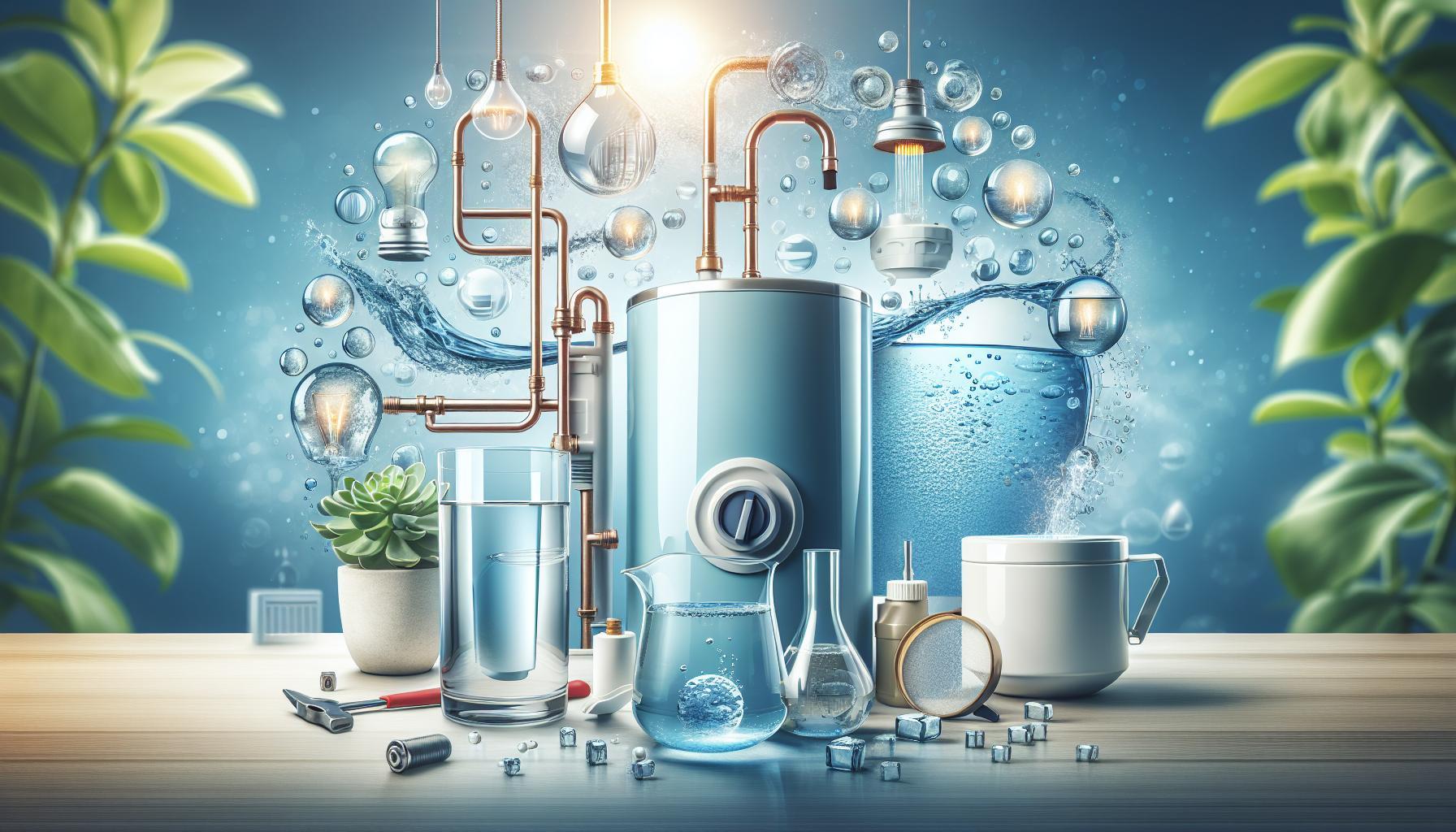Is your water heater showing signs of age? Knowing its lifespan is crucial for efficient home management and preventing unexpected failures. In this guide, we’ll share simple steps to determine your water heater’s age, helping you make informed decisions about repairs or replacements and ensuring your household enjoys reliable hot water.
Understanding the Lifespan of Your Water Heater
Understanding how long your water heater is expected to last is essential for effective maintenance and timely replacements. The lifespan of a typical electric water heater ranges from 10 to 15 years, but this can vary significantly based on usage, maintenance practices, and the quality of the unit. Knowing the age of your water heater, as explained in “How to Tell Age of Water Heater: Simple Steps to Find Out,” can help you anticipate potential issues and plan for replacements before unexpected failures occur.
To maximize the longevity of your water heater, consider the following factors:
- Regular Maintenance: Routine maintenance can prevent many common issues. Flushing the tank annually to remove sediment build-up is crucial, especially in areas with hard water that can affect performance.
- Anode Rod Replacement: The anode rod is designed to corrode instead of the tank. Regularly checking and replacing this component every few years can significantly extend your water heater’s lifespan.
- Temperature Settings: Keeping your water heater temperature at a safe level (usually around 120°F) not only conserves energy but also reduces wear and tear on the unit.
Identifying the Age of Your Water Heater
To efficiently assess the age of your water heater, look for the serial number typically located on the upper part of the tank. This number can give you insights that are essential for determining if it’s time for an upgrade. Many manufacturers encode the manufacturing date within the serial number, often using the first two digits to signify the year of production. If the tank is nearing or exceeds the 10-15 year mark, planning for a replacement should become a priority.
Signs Your Water Heater May Need Replacement
Be alert to changes in performance that might indicate your water heater is nearing the end of its lifespan. Common signs include:
- Inconsistent water heating
- Unpleasant odors or discoloration in the water
- Visible leaks or corrosion around the tank
- Strange noises such as popping or rumbling
By staying informed and proactive, you can ensure that your water heating system remains reliable and efficient, aligning with the best practices for home maintenance as supported by expert advice from “How to Tell Age of Water Heater: Simple Steps to Find Out.”
Key Indicators That Reveal Your Water Heater’s Age
Knowing the age of your water heater is crucial for maintaining an efficient and reliable hot water supply. Water heaters generally have an average lifespan of 10 to 12 years, but several factors, including water quality and maintenance, can significantly affect their longevity. Recognizing the key indicators that reveal the age of your water heater can help you decide whether it’s time for a replacement or if regular maintenance will suffice.
Identifying Serial Numbers
One of the most straightforward methods to determine your water heater’s age is by checking the serial number, which is typically located on the manufacturer’s label. Different manufacturers have unique coding systems, but many include the production date within the serial number. For example, if your water heater is from Rheem, the first four digits often represent the year and week of manufacture. If you’re uncertain how to decode the serial number, manufacturer’s websites often provide guidance on interpreting these codes.
Physical Condition and Performance
Take a close look at the physical condition of your unit. Signs of wear and tear, such as rust on the exterior, water leaks, or unusual noises, can indicate that your water heater is nearing the end of its useful life. Additionally, if your water heater frequently runs out of hot water or has inconsistent temperatures, it could be a sign of aging components. Regularly recording these performance issues can help you track when these problems began, giving you a better idea of your unit’s age.
Maintenance Records
Keeping a maintenance log can also provide insights into the age of your water heater. If you’ve documented routine upkeep or repairs, you can better assess how long your unit has been operational. A well-maintained water heater can last longer, so reviewing these records will help you evaluate whether the age of the unit impacts its efficiency.
- Check Manufacturer’s Label: Look for the serial number.
- Assess Physical Condition: Inspect for rust, leaks, and noisy operation.
- Review Maintenance Records: Document upkeep to understand the unit’s age.
By understanding these key indicators, you can make informed decisions about your water heater’s maintenance needs, ensuring that you enjoy a consistent supply of hot water for years to come.
Locating the Serial Number: Your First Step
Finding the serial number on your water heater is an essential first step in determining its age, which can significantly affect both its efficiency and your maintenance decisions. Knowing the age not only allows you to predict potential issues but also aids in planning for a timely replacement, ensuring that you avoid the inconvenience of unexpected failures.
To identify the serial number, the first step is to locate your water heater. Whether it’s tucked away in a basement, garage, or utility closet, make sure you have enough light to see clearly. The serial number is typically found on a sticker or label that’s attached to the side or the upper part of the tank. Here are some common places to check:
- On the main label on the side of the heater
- Near the bottom of the unit on the tank body
- On the manufacturer’s label, which often contains important information including the model number
Once you locate the sticker, take note of the serial number’s format. Most manufacturers encode the purchase date or the manufacturing date within the serial number itself, often using the first few digits to represent the year and sometimes the month. For example, if the serial number begins with “2016,” your water heater was likely manufactured in 2016. However, brands may differ in their encoding systems, so it is advisable to check the manufacturer’s website or contact their customer service for specific details related to your model.
If necessary, jot down the serial number and any associated model numbers in a secure location for future reference. This information can also be beneficial when seeking assistance or parts for the water heater. Always ensure to keep these details handy as they provide essential insights into how to tell the age of your water heater effectively.
Decoding the Serial Number: What It Tells You
Understanding the serial number of your water heater can be a revealing experience that not only helps you determine its age but also provides insight into its condition and warranty status. Each water heater is equipped with a unique serial number that encodes critical information, effectively serving as a fingerprint for your appliance. By decoding this number, homeowners can gain a clearer perspective on the lifespan and maintenance needs of their water heater.
Deciphering the Serial Number
Most manufacturers adhere to a specific format for their serial numbers, often including the date of manufacture. Typically, the first few characters will indicate the month and year the unit was produced. For instance, if your serial number starts with “A20,” the “A” may stand for January (with letters often representing months) and the “20” indicates the year 2020. This format can vary, however, so it’s essential to refer to the manufacturer’s specific decoding chart.
Here’s a brief overview of how different brands may format their serial numbers:
| Brand | Format Example | Decoded Information |
|---|---|---|
| A.O. Smith | 3A10 12345 | Manufactured in January 2020 |
| Rheem | 20E1234567 | Manufactured in May 2020 |
| Bradford White | 1234567890 | Can vary; consult specific references |
Additional Insights from the Serial Number
Beyond age, the serial number might inform you about the warranty period and features of the water heater. Many manufacturers provide warranties that last for a specific number of years after the date of manufacture. For example, if your unit has a ten-year warranty and was produced in 2020, you can safely assume that your coverage is valid until 2030. Additionally, checking the serial number with the manufacturer’s website can unveil any recalls associated with specific models, which can be crucial for ensuring safety and compliance.
By taking the time to decode your water heater’s serial number, you equip yourself with valuable knowledge about your appliance’s age and status. This can lead to more informed decisions regarding repairs, replacements, and maintenance, ensuring that you not only get the most out of your water heater but also maintain energy efficiency in your home.
Signs of Aging: Common Issues in Older Water Heaters
Recognizing the signs of aging in your water heater can save you from unexpected cold showers and costly repairs down the line. As these appliances age, they become susceptible to a variety of issues that can significantly impact their performance and efficiency. Understanding these common problems not only helps you determine how to tell the age of your water heater but also alerts you to potential maintenance or replacement needs.
Common Aging Symptoms in Water Heaters
With prolonged use, water heaters can exhibit several telltale signs of wear and tear:
- Rust or Corrosion: Visible rust on the exterior tank or along the plumbing connections suggests that the protective coatings are failing. This can lead to leaks and reduced effectiveness.
- Unusual Noises: As water heaters age, you might notice rumbling, popping, or hissing sounds. These noises are often due to sediment buildup, which can reduce heating efficiency.
- Inconsistent Temperature: If you experience fluctuating water temperatures, it may indicate that the heating element is becoming less effective or that there are issues with the thermostat.
- Water Leaks: Any signs of water pooling around the base of the unit or near the pipes requires immediate attention. This could be an early warning of tank failure.
- Age-Related Issues: Most water heaters have a lifespan of about 8-12 years. If your unit is approaching this age, it’s wise to consider its condition and efficiency.
Implications of Ignoring Aging Signs
Failing to recognize these symptoms can lead to more severe problems, necessitating premature water heater replacement. To help you keep track of your unit’s age, use the following table as a quick reference:
| Signs of Aging | Potential Issues | Recommended Actions |
|---|---|---|
| Rust or Corrosion | Leaking and reduced efficiency | Monitor for leaks; consider replacement. |
| Unusual Noises | Sediment buildup and inefficiency | Flush the tank; schedule a professional assessment. |
| Inconsistent Temperature | Heating element or thermostat issues | Test the temperature settings; replace malfunctioning parts. |
| Water Leaks | Potential tank failure | Shut off water supply; contact a plumber. |
| Age (8-12 years) | Increased risk of failure | Plan for inspection or replacement. |
Regular maintenance and timely interventions are crucial for prolonging the life of your water heater. By recognizing these signs, you can enjoy peace of mind knowing that you are taking proactive steps to ensure your appliance runs efficiently and effectively.
When to Consider Replacement vs. Repair
Deciding between repairing and replacing your water heater can feel like navigating a complex decision-making process, especially when you consider both cost and convenience. It’s essential to weigh these factors carefully, as making the right decision can save you time, money, and frustration in the long run. Understanding the age of your water heater is a crucial starting point—older units typically require more maintenance and are less energy-efficient, which can influence whether you should invest in repairs or search for a new model.
Key Considerations for Repair vs. Replacement
When evaluating whether to repair or replace your water heater, here are some key factors to consider:
- Age of the Unit: Water heaters generally last around 8 to 12 years. If yours is nearing the end of its life, replacement often becomes the more viable option, especially if it requires repairs.
- Type of Damage: Minor issues, like a faulty thermostat or a small leak, can typically be repaired at a reasonable cost. However, significant issues such as a broken heating element or extensive rust may necessitate a full replacement.
- Energy Efficiency: Old water heaters are usually less energy-efficient than newer models. If your utility bills are rising, investing in a new energy-efficient model could lead to long-term savings.
- Cost Analysis: Compare repair costs with the potential expenses of a new installation. If repairs exceed 50% of the cost of a new water heater, replacement may be your best bet.
Making the Decision
Keep in mind the following guidelines to help you decide:
| Factor | Repair | Replace |
|---|---|---|
| Unit Age | Less than 8 years | More than 12 years |
| Extent of Damage | Minor failures | Major issues or multiple repairs |
| Efficiency | Unit still efficient | High energy bills |
| Repair Costs | Less than 50% of replacement cost | More than 50% of replacement cost |
By weighing these considerations and using the insights from “How to Tell Age of Water Heater: Simple Steps to Find Out,” you can confidently choose whether to repair or replace your water heater, thus ensuring that you make the best investment for your home’s needs.
Regular Maintenance Tips to Extend Your Water Heater’s Life
To ensure your water heater operates efficiently and lasts as long as possible, regular maintenance is key. Many homeowners overlook this aspect of home care, but a few simple steps can significantly enhance the appliance’s lifespan and performance. By understanding the age of your water heater and implementing a consistent maintenance routine, you can avert costly repairs or replacements. Here are some practical tips to keep your water heater in excellent condition.
Regular Inspection
Frequent checks on your water heater can help you catch potential issues early. Begin by inspecting the exterior for any signs of rust or leaks, which can indicate a failing unit. Additionally, look for sediment buildup at the bottom of the tank. This sediment can reduce efficiency and lead to overheating. If you suspect your water heater is aging, refer to the article on how to tell the age of your water heater; this knowledge can guide your maintenance schedule and decision-making.
Flush the Tank
Over time, minerals in your water supply can accumulate at the bottom of the water heater tank, causing corrosion and inefficiency. Flushing the tank at least once a year can help remove this buildup. Here’s a quick guide to flushing your water heater:
- Turn off the power supply to the heater (for electric units) or turn off the gas (for gas units).
- Connect a garden hose to the drain valve at the bottom of the tank.
- Open the drain valve and let the water run until it is clear.
- Close the valve, refill the tank, and restore the power or gas.
Check the Anode Rod
The anode rod plays a critical role in preventing tank corrosion. Typically made of magnesium or aluminum, this rod attracts corrosive elements in the water, thereby protecting the tank itself. Check the anode rod every couple of years—if it’s more than 75% corroded, replace it to prolong the life of your water heater.
| Aspect | Recommendation |
|---|---|
| Inspection Frequency | Every 6 months |
| Flushing Frequency | Once a year |
| Anode Rod Check | Every 2-3 years |
Temperature Setting
Setting your water heater to the optimal temperature also contributes to its longevity. Ideally, the thermostat should be set to 120 degrees Fahrenheit. This temperature is sufficient for most household needs and reduces the risk of scalding, while also minimizing energy consumption and wear on the system.
By incorporating these practices into your annual home maintenance routine, you can effectively extend the lifespan of your water heater and ensure it continues to provide reliable service. Regular monitoring and proactive maintenance are key strategies in avoiding premature failure and keeping your home’s hot water supply flowing smoothly.
The Importance of Knowing Your Water Heater’s Age for Efficiency
Knowing the age of your water heater is crucial for ensuring it operates efficiently and effectively, as the lifespan of these systems is often confined to a span of 10 to 15 years. As water heaters age, they can become less efficient, leading to higher utility bills and potential emergency breakdowns. By recognizing the age of your water heater, you can assess whether it is time for maintenance or even replacement, thus avoiding unexpected costs and inconveniences.
Regular maintenance is vital for prolonging the lifespan of your water heater, but even with the best care, wear and tear will occur over time. Older units may exhibit signs of rust, sediment buildup, or inconsistent heating—indicators that the appliance is nearing the end of its service life. According to industry standards, understanding “how to tell the age of your water heater: simple steps to find out” can empower homeowners to tackle issues proactively rather than reactively. For instance, if your water heater is over a decade old and shows these signs, it may be time to consider a replacement, ensuring you remain within the efficiency window of modern units.
Efficiency and Cost Savings
Investing in a new water heater can yield significant savings. New models typically have enhanced energy efficiency ratings, which translates to lower energy consumption and reduced monthly utility bills. In that context, it’s essential to consider not only the age of your water heater but also the advantages of upgrading to a more efficient system. Doing so can offset the initial investment over time due to lower operation costs.
- Identify your water heater’s age using the manufacturer’s sticker, which often indicates the date of manufacture.
- Monitor performance issues such as fluctuating water temperatures or increased noise levels.
- Factor in maintenance history, as well-cared-for units may last longer, even if they are older.
In summary, knowing the age of your water heater is not just a matter of curiosity; it is a critical aspect of home maintenance. By staying informed about your water heater’s age, you can enhance its efficiency, ensure safety, and save on costs, ultimately leading to better performance and peace of mind for your household.
FAQ
How to Tell Age of Water Heater: Simple Steps to Find Out?
To determine the age of your water heater, check the serial number on the manufacturer’s label. Most manufacturers include a date code within this number, indicating its production date.
Each brand has different coding, so consulting the manufacturer’s website or documentation may be necessary for precise identification. Manufacturers like Bradford White typically follow specific patterns that can help pinpoint the year of manufacture. For detailed steps, check guides on how to find your water heater’s age.
What is the average lifespan of a water heater?
The average lifespan of a water heater is typically around 10 to 12 years. Factors such as maintenance and water quality can affect durability.
Regular maintenance, including flushing and checking the anode rod, can extend the life of your unit. If your water heater is approaching this age, it may be wise to consider a replacement to avoid future issues.
Can I find out my water heater’s age without a label?
If the label is unreadable or nonexistent, you can still estimate your water heater’s age by looking at its design and components. Older models may differ significantly in style compared to newer ones.
Additionally, checking past purchase records or consulting your plumber can provide clues. If the heater was installed during a known renovation, that date may help establish its age.
Why does knowing the age of my water heater matter?
Knowing your water heater’s age is important for maintenance and replacement planning. An older unit may be less efficient and prone to failure.
If it’s near the end of its lifespan, you could face unexpected repairs. Regularly checking the age allows you to budget for a replacement ahead of time and avoid costly emergencies.
How can I tell if my water heater is nearing the end of its life?
Signs that your water heater may be nearing the end of its life include leaks, rust, and inconsistent water temperatures. If the water is discolored or has an odor, that may also indicate deterioration.
Regular inspections can help catch these issues early. If your unit is over a decade old and showing these signs, it might be time to consider a replacement.
What should I do if my water heater is old?
If your water heater is approaching its average lifespan, consider having it inspected by a professional. They can advise whether repairs are possible or if replacement is the better option.
Planning for replacement in advance can save you from emergency situations and allow you to choose a unit that fits your needs and is more energy-efficient.
How to tell if my water heater is still under warranty?
To determine if your water heater is still under warranty, check the manufacturer’s specifications associated with the serial number. Most warranties last between 6 to 12 years.
Documentation from the purchase can also clarify warranty details. If in doubt, contacting the manufacturer directly with your model and serial number can provide specific information.
The Way Forward
In conclusion, determining the age of your water heater is a straightforward process that can save you time and money. By checking the serial number and understanding its components, you can effectively assess whether it’s time for a replacement or if it still has years of reliable service ahead. We encourage you to explore our detailed guides linked throughout this article, which offer further insights into water heater maintenance and replacement tips. Empower yourself with knowledge, and don’t hesitate to take the next step in ensuring your hot water system meets your household needs efficiently!






